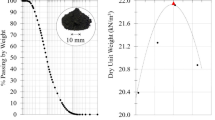Abstract
The effect of polypropylene fibre and weld slag on the mechanical properties of High Performance Concrete (HPC) containing silica fume as the mineral admixtures was experimentally verified in this study. Sixteen series of HPC mixtures(70 MPa) were designed with varying fibre fractions and Weld Slag (WS). Fibre added at different proportion (0, 0.1, 0.3 and 0.6%) to the weight of cement. Weld slag was substituted to the fine aggregate (0, 10, 20 and 30%) at volume. The addition of fibre decreases the slump at 5, 9 and 14%, whereas the substitution of weld slag decreases by about 3, 11 and 21% with respect to the control mixture. Mechanical properties like compressive strength, split tensile strength, flexural strength, Ultrasonic Pulse Velocity test (UPV) and bond strength were tested. Durability studies such as Water absorption and Sorptivity test were conducted to check the absorption of water in HPC. Weld slag of 10% and fibre dosage of 0.3% in HPC, attains the maximum strength and hence this combination is most favourable for the structural applications.






Similar content being viewed by others
References
S. Aydın, B. Baradan, The effect of fibre properties on high performance alkali-activated slag/silica fume mortars. Compos. Part B 45, 63–69 (2013)
Abou-Zeid MN, Fahmy EH, Massoud MT. Interaction of silica fume and polypropylene fibres in high performance concrete, 2nd Material Speciality Conference of the Canadian Society for Civil Engineering, (2002)
R. Annoni et al., Submerged-arc welding slags: characterization and leaching strategies for the removal of aluminium and titanium. J. Hazard. Mater. 244–245, 335–341 (2013)
K. Singh, V. Sahni, S. Pandey, Slag recycling in submerged arc welding and its influence on chemistry of weld metal. Asian J. Chem. 21, 47–51 (2009)
Harun Tanyildizi, Statistical analysis for mechanical properties of polypropylene fibre reinforced lightweight concrete containing silica fume exposed to high temperature. Mater. Des. 30, 3252–3258 (2009)
P. Zhang, Q.-F. Li, Effect of polypropylene fibre on durability of concrete composite containing fly ash and silica fume. Compos. Part B 45, 1587–1594 (2013)
Viana et al., The use of submerged-arc welding flux slag as raw material for the fabrication of multiple-use mortars and bricks. Soldagem Insp. Sao Paulo 14, 257–262 (2009)
Ramesh et al., Use of furnace slag and welding slag as replacement for sand in concrete. Int. J. Energy Environ. Eng. 4, 3 (2013). https://link.springer.com/article/10.1186/2251-6832-4-3. Accessed 25 Oct 2017
IS (Indian Standard) (1987) IS12269: Specification for 53 grade Ordinary Portland cement
IS (Indian Standard) (1970) IS 383: Specification for coarse and fine aggregates from natural sources for concrete (second revision)
ASTM C 1116–03 Standard Specification for Fibre-Reinforced Concrete, ASTM International, West Conshohocken, PA, (2003). https://www.astm.org/. Accessed 25 Oct 2017
A. Ananthi and J. Karthikeyan., Performance of polypropylene fibre in high-performance concrete. Proc. ICE-Construct. Mat. 168(6), 263–266 (2015). doi:10.1680/coma.15.00004
ACI (American Concrete Institute) ACI 211.1-91 Standard Practice for Selecting Proportions for Normal, Heavyweight and Mass Concrete, (1998)
Aitcin PC. High Performance Concrete. University De Sherbrooke, Quebec, Canada, First published 1998 by E & FN Spon, an imprint of Routledge 11 New Fetter Lane, London. (2004)
IS (Indian Standard) IS 516: Methods of tests for strength of concrete, (1959)
IS (Indian Standard) IS 5816: Splitting Tensile strength of concrete -Method of test, (1999)
IS 2770 Part (1):1967 (reaffirmed 2002) Methods of Testing bond in Reinforced Concrete. Part 1, Pull out test
N. Ganesan, P.V. Indira, M.V. Sabeena, Bond stress slip response of bars embedded in hybrid fibre reinforced high performance concrete. Constr. Build. Mater. 50, 108–115 (2014)
ASTM C642-13: Standard Test Method for Density, Absorption and Voids in Hardened Concrete, ASTM International, West Conshohocken, PA, (2013). https://www.astm.org/. Accessed 25 Oct 2017
ASTM C1585-13 Standard Test Method for Measurement of Rate of Absorption of Water by Hydraulic-Cement Concretes, ASTM International, West Conshohocken, PA, (2013). https://www.astm.org/. Accessed 25 Oct 2017
Author information
Authors and Affiliations
Corresponding author
Rights and permissions
About this article
Cite this article
Ananthi, A., Karthikeyan, J. Combined Performance of Polypropylene Fibre and Weld Slag in High Performance Concrete. J. Inst. Eng. India Ser. A 98, 405–412 (2017). https://doi.org/10.1007/s40030-017-0248-5
Received:
Accepted:
Published:
Issue Date:
DOI: https://doi.org/10.1007/s40030-017-0248-5




